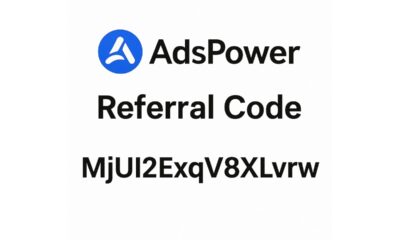Business
A Comprehensive Guide to Mortgage Refinancing

In short, a refinance of a mortgage is the replacement of one mortgage with another. When interest rates are high, people tend not to refinance their mortgages. Since 2022, average rates have been gradually increasing, peaking at 7.79% for a 30-year fixed-rate mortgage at the end of October 2023. They have, however, substantially decreased since then and, as of April 4, 2024, were at just 6.82%, which has some considering refinancing.
Refinancing is typically done by persons whose interest rates have fallen below their mortgage rate. Over the course of your loan, a refinance might save you thousands of dollars if the prerequisites are met. You may also be able to turn the equity in your house into cash.
Let’s look at the specifics of mortgage refinancing, including how it operates, the benefits and drawbacks, and the necessary actions.
How does refinancing a mortgage operate?
Applying for a new mortgage is comparable to the procedure of refinancing an existing one. Your lender will examine your credit once you submit your application, and you’ll need to present financial records. Your home may need to be appraised, as required by the lender.
Benefits and Drawbacks of Mortgage Refinancing
Advantages:
It’s possible that you could get a cheaper interest rate.
It’s possible for you to lower your amortization.
To cover large expenses like home renovations, you might use your equity in your house.
Cons:
Setup fees may be high.
Refinancing could result in a longer mortgage payback period.
Penalties could apply if you break your current mortgage.
types of refinancing mortgages
Mortgage refinancing comes in a variety of forms. Your goals and financial position will determine which option is best for you.
Refinancing with cash in
A cash-in refinance lowers your principle amount by allowing you to make a lump-sum payment on your mortgage. This is the best option for those who wish to get rid of private mortgage insurance, reduce their loan-to-value ratio, or hope for a lower interest rate.
Refinancing with cash out
You can use a cash-out refinance to convert a portion of the equity in your house into cash. Although this will result in an increase in your mortgage’s main balance, you can utilize the money for a variety of purposes, such as debt repayment or home improvement.
Simplify your refinancing
Compared to a standard refinance, a streamline refinance needs fewer paperwork and underwriting. There is no need for an evaluation, however the maximum amount of cash back is $500. Loans from the Federal Housing Administration (FHA), the Department of Agriculture (USDA), the Department of Veterans Affairs (VA), Freddie Mac, and Fannie Mae can be used for streamline refinances.
Refinance at a rate and term
You can adjust your loan’s interest rate and/or repayment conditions using a rate-and-term refinance.
Brief Refinancing
Your lender may consent to a quick refinance in place of costly foreclosure procedures if you are having trouble making your monthly mortgage payments or if you have fallen behind on your payments. As a result, you’ll receive a loan with a smaller principal sum and a smaller monthly payment. The difference will then be forgiven by the lender. Remember that a quick refinance could lower your credit rating.
Procedures For A Mortgage Refinance
These are the actions you should follow if you’re prepared to refinance your mortgage.
Recognize The Reasons For Your Refinancing
Prior to refinancing, you should be aware of your objectives. Do you want your interest rate to drop? Would you like to use the equity you have accumulated to do a project around the house? Prior to beginning, you should be aware of your objectives so that you can determine whether refinancing makes sense for your circumstances.
Verify Your Credit Rating
You need your credit score to be higher than the minimum in order to be eligible for a mortgage refinance. Depending on the kind of loan you’re applying for, this will vary. Here are some instances of minimal credit scores:
The interest rate that you are offered will depend on your credit score. Before refinancing, work on raising your score for a few months if it isn’t as high as you’d want.
Take Into Account Additional Lender Criteria
In addition to a minimum credit score, the majority of lenders have additional requirements for underwriting mortgage loans. A good income and debt-to-income ratio (DTI) are part of this. Here’s a closer examination at each:
Ratio of debt to income (DTI)
Your debt-to-income ratio (DTI) is the total amount of debt you have each month divided by your monthly income. Lenders will find it more risky to lend you money if your DTI ratio is greater. Although the precise figure will differ according on the lender, a typical guideline to strive for is no more than 45%. You may be eligible for reduced interest rates if you can get it closer to 36%.
Revenue
To ensure you can pay off the loan, your lender will want to see proof of your income. It will ask to see your most recent pay stubs for verification. You have to turn in 1099s or your last two years’ tax returns if you work for yourself.
Examine The Equity In Your House
Before contemplating refinancing, most lenders need at least 20% equity in your house. The likelihood that you will fail on the loan decreases with increasing equity.
Find out how much you still owe on your mortgage to find the equity in your property. You can find this information on your monthly statement. Next, obtain a reliable assessment of the current worth of your house by visiting Zillow.com. You may also decide to have an appraisal done, but since your lender will probably need a second evaluation before closing, it might not be worth the expense.
You’ll be better able to decide whether you can proceed with refinancing after you are aware of your mortgage debt and your home’s current valuation.
Compare mortgage lenders
It’s time to start looking for a lender once you’ve determined that refinancing your mortgage is the best course of action and your finances are in order. Make sure you weigh your options carefully in order to select the best one. Always consider your current lender first, as they could be able to waive part of your refinancing costs.
The interest rate and closing costs—including whether they will be paid upfront or rolled into your loan—should be taken into account when selecting a lender. To prevent changes, you should lock in the rate as soon as you select your lender.
Prepare Your Documentation
- Get ready for the evaluation
For their part, most mortgage lenders need an assessment to ascertain the current value of your house. Your home will be inspected by the appraiser, who will then evaluate it using a checklist of items. They’ll also take into account recent comparable sales of houses in the area.
Mention any home renovations you’ve done since buying the house while the appraiser is in your house. This may be an additional bathroom, a refurbished kitchen, or a finished basement. The appraiser may view your home as having more value if you do these things.
Concluding The Loan
It’s time to close once the loan has been approved and the home appraisal satisfies the lender’s requirements. You will reimburse the lender for the closing costs on the day of closing. You can get a detailed explanation of the costs in the closing disclosure or your loan estimate.
Almost all lenders permit you to cover the closing charges with cash. Some will let you incorporate the closing expenses into the loan amount with a no-closing-cost refinance. This frequently results in a higher interest rate even though it will lower the amount you have to pay on closing day. Discuss your options with your lender to determine which is best for you.
How Much Does It Cost To Refinance a mortgage?
You have to reimburse the lender for closing expenses when you refinance your mortgage. This usually represents between 2% and 5% of the total loan amount. For instance, the total cost will be $6,000 if your loan is for $300,000 and closing charges are 2%.
In order to prevent unpleasant surprises, you should also inquire with your present lender. In some cases, if you pay off the entire loan amount before the term expires, the lender will charge you a prepayment fee. In your first loan documentation, this would have been mentioned.
Cut Back On Your Monthly Installment
Reducing your monthly mortgage payment is a wonderful reason to refinance. Your monthly payment following a refinance will probably be cheaper if interest rates are lower now than they were when you originally obtained your mortgage.
Pay Down Your Mortgage More Quickly
You may wish to pay off your mortgage sooner if you originally had a 30-year mortgage. It could be wise to refinance into a 10, 15, or 20-year mortgage in this situation.
Convert The Equity In Your House Into Cash
When is it worthwhile to refinance a mortgage?
It’s not always the wisest financial decision to refinance a mortgage. Here are a few instances where it does make logic.
Cut back on your monthly installment
Reducing your monthly mortgage payment is a wonderful reason to refinance. Your monthly payment following a refinance will probably be cheaper if interest rates are lower now than they were when you originally obtained your mortgage.
Pay down your mortgage more quickly
You may wish to pay off your mortgage sooner if you originally had a 30-year mortgage. It could be wise to refinance into a 10, 15, or 20-year mortgage in this situation.
Convert the equity in your house into cash
A cash-out refinance is something to think about if you want to leverage your home equity to pay off other debts or home improvement projects. You might be able to access your equity and reduce your interest rate if refinancing at a time when rates are lower than when you got your mortgage in the first place.
Take away private mortgage insurance
When your loan total exceeds 78% of the original value of your house, lenders are generally required to immediately eliminate your private mortgage insurance; however, you have the option to do so when it reaches 80%. You can accomplish this via a refinancing.
Convert your mortgage from an adjustable to a fixed rate
Some choose for adjustable-rate mortgages because they want to take advantage of the lower interest rates available, or because they don’t think they will live in the house for a long time. But before the loan term ends, some borrowers with adjustable-rate mortgages may want to refinance into a fixed-rate mortgage.
-

 Travel4 weeks ago
Travel4 weeks agoBwindi’s Gorilla Tourism: Saving Wildlife, Empowering Communities
-

 Education4 weeks ago
Education4 weeks agoJoseph Curran: Using Legal Writing and Advocacy to Simplify Complex Issues for Clients
-

 Tech4 weeks ago
Tech4 weeks agoGoogle Offers New Travel-related Features To Search And Launches Its AI “Flight Deals” Tool Around The World
-

 Business4 weeks ago
Business4 weeks agoStop the Bleeding: How Unanswered Comments Increase Your CAC
-

 Cryptocurrency2 weeks ago
Cryptocurrency2 weeks agoRami Beracha Asks, Can Israel Become A Global Leader In Blockchain Innovation?
-

 Tech3 weeks ago
Tech3 weeks agoAdsPower Promo Code for 50% Off – Ultimate Guide to AdsPower Benefits (Referral Code Included)
-

 Education2 weeks ago
Education2 weeks agoForged in Fire: Nicholas Lawless Unveils Lawless Leadership – The Model Built for a World That Traditional Leadership Can’t Survive
-

 Business2 weeks ago
Business2 weeks agoOPO Group LTD Strengthens Its Global Footprint With Expanding Offices and a Modernized Trading Ecosystem














